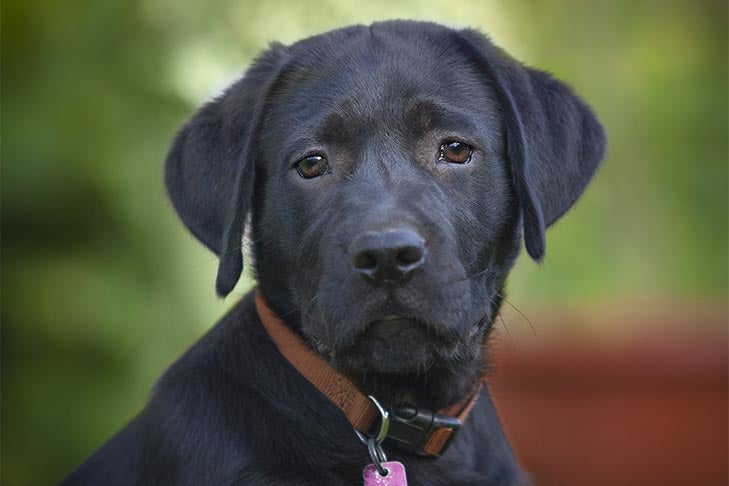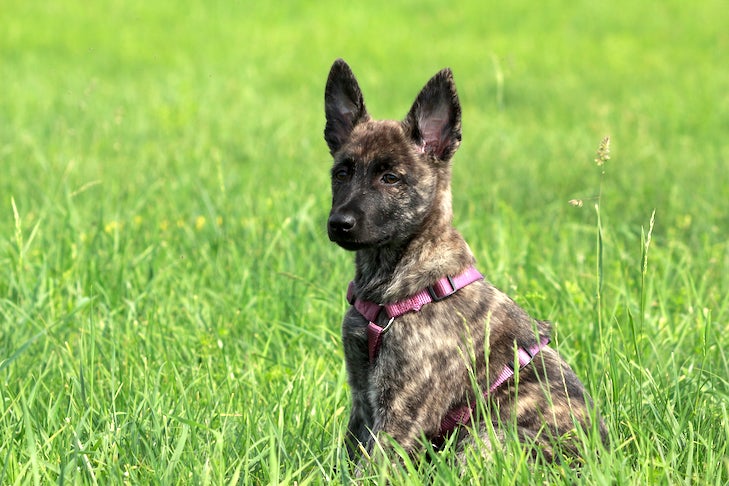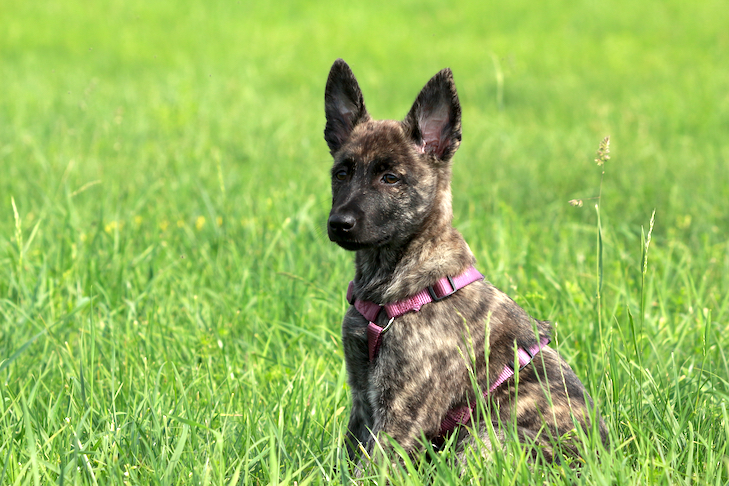Clubs Offering:
You would think picking out a leash and collar for your new puppy is a simple enough task — until you walk into a pet store and are met with an overwhelming number of options. Which is better for my puppy: collar or harness? What are all these different types of collars and harnesses for, exactly? These are important questions, and the answers will help you choose the safest option for your dog.
Whichever you end up choosing, just remember that no collar or harness is safe for a puppy to wear without supervision, so be sure to remove it before shutting your pup inside a crate or leaving them unattended.
This is your basic dog collar. These collars come in leather, woven nylon or cloth varieties, and they can often be found in cute colors and patterns, sometimes accessorized with bling, bow ties, bandanas and other ways to show off your dog’s personality. They’re easy to find, affordable, and they’re great for displaying ID tags. Rolled collars tend to be a bit sturdier and hold up better for active dogs who put a lot of wear and tear on their collars, but because they’re raised from the neck and can catch on things more easily and cause choking, they’re generally not recommended for puppies.
These standard types of collars have a major drawback, however. “[Both flat and rolled] collars can cause damage to the trachea,” says Dr. Sara Ochoa, DVM, veterinary consultant for DogLab. “Tracheal collapse is when your dog’s tracheal rings weaken, causing them to collapse when your dog breathes in and out. This can cause narrowing in your dog’s trachea.” This can be a danger for puppies learning to walk on a leash and older dogs who have a tendency to pull.
Certified dog behavior consultant Kayla Fratt, founder of Journey Dog Training, agrees. “Once my dogs are trained to walk nicely on a leash, we simply use a flat buckle neck collar. Until they walk nicely, however, I use a back-clip harness to protect their throats from pulling.”
Another potential danger of these types of collars is that they can increase eye pressure. A 2006 study in the Journal of the American Animal Hospital Association found that the force generated by a dog pulling against a standard neck collar can significantly increase pressure in the eyes, and shouldn’t be used on dogs who have glaucoma, weak corneas or other eye conditions.

These types of collars are sometimes used in training. Choke collars slip around a dog’s neck and tighten uncomfortably when the dog pulls against it, whereas prong collars are lined with blunt prongs that place pressure on the neck. When used correctly, these collars are intended only to get the dog’s attention, and not as a means of punishment.
While some trainers find these collars effective on high-drive breeds like Belgian Malinois, who don’t always respond well to other training methods, many trainers disavow their use, including Kayla Fratt. “I recommend relying on games and treats to teach your dog not to pull, not finding equipment that makes pulling painful for your dog,” she says. These collars are not for everyday use and should only be used under the supervision of a professional trainer, and they should never be used on puppies younger than six months.
A hybrid between a choke collar and a flat collar, Martingale collars are designed with stops that make them less restrictive than choke collars and prevent them from squeezing the neck. Properly designed Martingales sit high on the neck, avoiding the trachea, and offer more control of the head, which makes dogs more responsive to direction. Poorly designed Martingale-style collars, however, tend to slip down and have the same drawbacks as regular flat collars. Also, poorly fitted collars can easily slip off over the head, making it easy for puppies to slip out and run away.
These are flat collars with a fastener that easily breaks open when a dog or puppy pulls hard enough. A safety collar can be a good option in a situation where you need your pup to wear ID or proof of vaccination but are concerned about choking, such as at play dates with rambunctious dogs or at an off-leash dog park. But the breakaway design makes these collars a poor choice for leash walking.


Harnesses fit around your dog’s chest and torso, keeping pressure off of the neck. They come in a variety of materials and styles, but there are two main types you should be aware of.
This is the most common type of harness, with a D-ring located in the middle of the back for attaching a leash. These harnesses tend to be more comfortable for dogs, and are generally a good choice for brachycephalic breeds–those with flat faces, such as Pugs or Bulldogs, which are more prone to tracheal collapse. They also tend to be a better choice for breeds in the Toy Group, which tend to be more fragile, and for dogs with long, delicate necks, like Greyhounds.
One drawback of back-clip harnesses is that they can encourage pulling, especially with breeds like Siberian Huskies or Alaskan Malamutes that are bred to pull heavy objects. “I still recommend back-clip harnesses for jogging, biking, or hiking,” says Fratt. “They’re great in situations where comfort and freedom are the priority for the dog or in situations where a bit of pulling is expected.”
These harnesses have the D-ring located in the front of the chest. This design is meant to discourage pulling, which can be a good choice for heavy pullers, especially large breeds who could jerk you off your feet. However, depending on the design, some front-clip harnesses can constrict your pup and end up causing damage. “While they may reduce your dog’s pulling power, having a strap that shortens their stride and pulls them to the side is bad for their posture and musculature,” says Fratt. “Look for a front-clip harness that is Y-shaped rather than one that has a strap across their chest.”
Contents of this article:
The best time to start using a harness is when your puppy first comes home from their breeder.
You can introduce it as early as eight weeks old, but bear in mind they grow quickly and you’ll want to make sure you get a good fit in the right size for them.
When should you begin harness training your puppy?
Start harness training your puppy as soon as possible practically from day one!
Should puppies wear a collar or a harness?
All dogs must wear a collar with identification, it’s the law, so there is no “or” about it. But the question “should puppies wear a collar and a harness?” is relevant. Most dog owners who have a well trained dog who walks to heel and has good recall, happily just use a collar and lead. Their dog won’t be pulling whilst on the lead so there won’t be unnecessary pressure on their necks. However, someone who’s dog is a puller might end up using a collar AND a harness when they are out and about.
For some short-nosed breed puppies such as bulldogs and pugs, who are prone to respiratory issues, a harness will be the best choice to avoid pressure on the windpipe. Otherwise your decision on using a harness will depend on your training progress and personal preference. Every puppy is different and has his or her own personality. If you are attending puppy classes, your trainer may be able to help with whether your puppy needs a harness or not.
Collar or Harness for Puppies – Which one to pick?
Being a pet lover, I’m sure you care about your dogs health, wellbeing and safety above all else. This is why harness training is so important. A harness is often the best option for your dog, especially if your four-legged friend is a bit of a puller. In these instances, using collars is dangerous, because it compresses the structures in the neck. This is especially dangerous in breeds such as Yorkshire terriers, which are predisposed to a collapsing windpipe, a condition which can eventually be life-threatening. Another example of harnesses protecting the safety of your pet is when they’re out on the lead, before they are trained to walk off lead. Having a harness on your dog, and therefore good control of them, means you can avoid hazards such as an aggressive dog walking around off lead or environmental hazards such as steep drops. These are hazards that your young pup may not be aware of as they’re just a baby working out how the world works. Therefore, it is extremely important to train your pup to wear a harness from a young age.
Another reason why there’s no excuse not to harness train your pup is that it’s super easy. Most dogs will take to a harness well, with few exceptions. Puppies can be taught to wear a harness practically from day one as well, as you’ll get your pup at a minimum of 8 weeks of age. Give them a chance to settle in for a few days and then start teaching them. Wearing a harness will also come in handy in the car as you can strap them in with a doggy seatbelt, another example of why harnesses are better than collars and how it will keep your pupper safe– it is also a legal requirement in many places to have your pup either strapped in or in a crate during car journeys. Although it’s best to teach your fluffy friend when he’s young, older dogs that are more set in their ways can also be taught this trick with relative ease and getting them used to the harness should take a few days at the most.
To get started, you’ll need a quiet environment for your pupper to learn. Try playing with him first to wear him out a little, but not too much as you don’t want him to take a pup nap. You’ll need a comfortable, well-fitting harness. It’s well worth investing time and money in finding the correct one, as the last thing you want to do is cause your pup any discomfort. You’ll want to buy one from a reputable pet store or manufacturer of dog harnesses. And of course, you’ll want some tasty treats to reward your pooch when he’s a good boy and accepts the harness well.
Get your pooch to love that brand new harness. Pop it on the floor and let him have a good sniff.
Give your pupper a delicious treat and tell him how much of a good boy he is when he shows interest in the harness.
It is well worth desensitizing your pup to the harness by giving him a day where it’s just lying around the house and he can show interest in it, this way he’ll be less scared when you put it on him, as it’s a familiar object.
Pop your pupper into the harness. As harnesses can be variable, be sure to read the instructions so you can fit it properly. This might be a two-man job, and can be easier if you get someone else to hold the pup while you fit the harness. Make sure you give your pup a treat and lots of praise when he wears the harness around the house to begin with.
You don’t want your pupper associating the harness with bad experiences, so take them to one of their favorite places to walk. Make sure their vaccinated before you venture outside with them though!
Make sure you choose the right harness for your pupper; an older dog will be more set in his ways. Ask the pet shop or manufacturer for advice on what harnesses your breed of pooch tends to like.
Older dogs will tend to get excited when they see a harness, or anything that relates to going walking for that matter. To desensitize them to it, keep the harness somewhere accessible so that he’s used to it but loses interest in it pretty quick.
Put the harness on in the house, giving your pup much praise when he accepts it. Let your pooch wear the harness for the afternoon.
You don’t want your pup to associate the harness with bad things, so make sure you give him praise when he does things right, rather than telling him off if he’s playing up in it.
By now, your pooch should be ready to go out walking in his smart new harness. Be sure to also teach him how to heel, so he doesn’t pull on the harness too hard.
Introduce your pupper to the harness by letting him have a good sniff. Give him a treat when he shows interest.
Place the harness on your puppers neck/back in a similar position to how it will go on. Do this for 10 seconds and give him a treat and lots of praise if he accepts this. Repeat this a few times.
If your pupper is behaving with the harness placed on his neck/back, he should now be ready for it to be tightened. Give your pupper a big fuss and a treat if he accepts the harness.
Keep taking the harness on and off of your pupper, giving him a treat each time he has it on- but only if he is behaving. If not, keep repeating this process until he does and give him a treat and a big fuss then. This means that your put will enjoy wearing the harness as he will associate it with praise.
Have a go at walking him around the house with the harness on, giving him treats and praise when he behaves well. Now you’ll be ready to take him outside, when he’s had all his vaccines, of course.